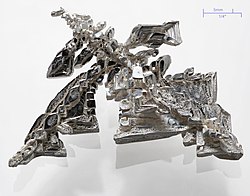Silver
Silver has long been valued as a precious metal, and is used as an investment, to make ornaments, jewelry, high-value tableware, utensils (hence the term silverware), and currency coins. Today, silver metal is also used in electrical contacts and conductors, in mirrors and in catalysis of chemical reactions. Its compounds are used in photographic film, and dilute silver nitrate solutions and other silver compounds are used as disinfectants and microbiocides (oligodynamic effect). While many medical antimicrobial uses of silver have been supplanted by antibiotics, further research into clinical potential continues.
Occurrence and extraction
Silver is found in native form, as an alloy with gold (electrum), and in ores containing sulfur, arsenic, antimony or chlorine. Ores include argentite (Ag2S), chlorargyrite (AgCl) which includes horn silver, and pyrargyrite (Ag3SbS3). The principal sources of silver are the ores of copper, copper-nickel, lead, and lead-zinc obtained from Peru, Bolivia, Mexico, China, Australia, Chile, Poland and Serbia. Peru, Bolivia and Mexico have been mining silver since 1546, and are still major world producers. Top silver-producing mines are Cannington (Australia), Fresnillo (Mexico), San Cristobal (Bolivia), Antamina (Peru), Rudna (Poland), and Penasquito (Mexico).[39] Top near-term mine development projects through 2015 are Pascua Lama (Chile), Navidad (Argentina), Jaunicipio (Mexico), Malku Khota (Bolivia), and Hackett River (Canada).
The metal is primarily produced as a byproduct of electrolytic copper refining, gold, nickel, and zinc refining, and by application of the Parkes process on lead metal obtained from lead ores that contain small amounts of silver. Commercial-grade fine silver is at least 99.9% pure, and purities greater than 99.999% are available. In 2011, Mexico was the top producer of silver (4,500 tonnes or 19% of the world's total), closely followed by Peru (4,000 t) and China (4,000 t).
| Symbol | Ag | |
| Atomic Number | 47 | |
| Atomic Weight | 107.8682 | |
| Oxidation States | +1 | |
| Electronegativity, Pauling | 1.93 | |
| State at RT | Solid, Metal | |
| Melting Point, K | 1235.1 | |
| Boiling Point, K | 2485 |
Appearance and Characteristics
Harmful effects:
Silver is considered to be non-toxic. However, most silver salts are poisonous and some may be carcinogenic.
Characteristics:
- Silver is a soft, ductile, malleable, lustrous metal. It has the highest electrical and thermal conductivity of all metals.
- Silver is stable in oxygen and water, but tarnishes when exposed to sulfur compounds in air or water to form a black sulfide layer.
- Sterling silver (an alloy of 92.5% silver and 7.5% copper) or Britannia silver (an alloy of 95.8% silver and 4.2% copper) are used for jewelry and silverware.
- Silver is used as a food additive/coloring and is given the E number E174.
- About 30% of silver produced is used in the photographic industry, mostly as silver nitrate.
- Silver is used in solders, electrical contacts, and silver-cadmium and silver-zinc batteries. Silver paints are used in the manufacture of electronic printed circuits.
- It is used in superior mirror production, as silver is the best known reflector of visible light, although it does tarnish over time.
- Silver iodide is used in artificial rain making to seed clouds.
- Silver compounds were used successfully to prevent infection in World War 1.
Silver tarnishes quickly in sulfur dioxide released from a boiled egg, then the tarnish is instantly removed using electrochemistry.
A demonstration of basic photography using silver chloride.
